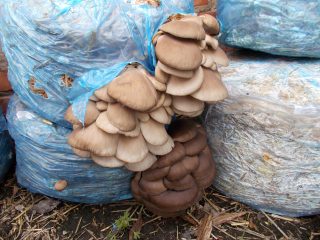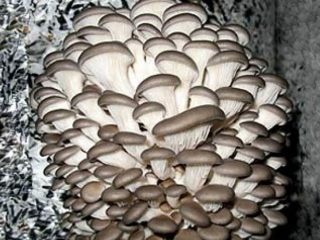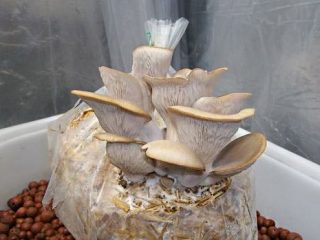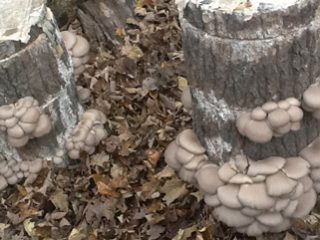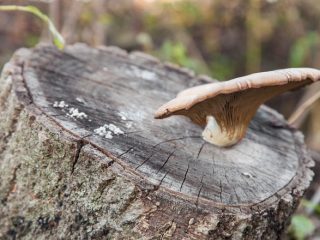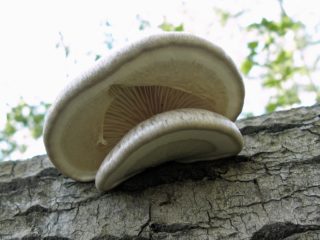Content
Oyster mushroom is an edible lamellar mushroom belonging to the Oysteraceae family. Another name is abundant oyster mushroom. Outwardly it resembles a shepherd's horn. Found in the wild and grown artificially.
Where does oyster mushroom grow?
Under natural conditions it grows in the steppe and forest-steppe zones of Russia and Ukraine, as well as in the North Caucasus, Japan, and China. Mushrooms grow on the remains of deciduous trees and are found on elms. They love hard-to-reach secluded places: dead wood of maple and oak, dense thickets of bushes, clearings, and windbreaks.
It bears fruit from May to September, according to some sources – until November. Grows in groups of up to 15 pieces.A description and photo of oyster mushroom is presented below.
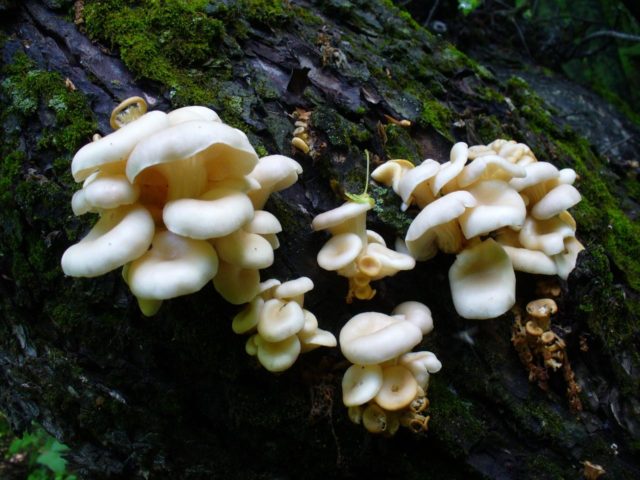
Representatives of the species always grow in groups
What does oyster mushroom look like?
The cap in adult specimens is elongated, has a funnel- or horn-shaped shape, less often leaf-shaped with an upward bend or tongue-shaped. In young people it is tucked inward and convex. Diameter - from 3 to 10 cm. The surface is smooth, the color varies depending on the place of growth and age from almost white to grayish-ochre. The pulp of the mushroom is practically odorless or has a slightly floury aroma, elastic, thick, white; in older mushrooms it is fibrous and hard.
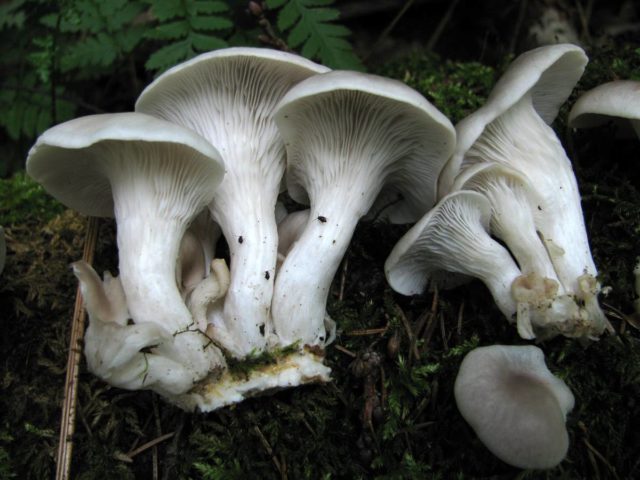
A distinctive feature of its appearance is its rather long stem, well separated from the cap.
The plates are white, rather sparse, narrow, sinuous, descending, intertwined at the bottom to form a pattern. White spore powder.
The length of the leg is from 3 to 8 cm, thickness – up to 1.5 cm. It is pronounced, unlike other types of oyster mushroom, and is well separated from the cap. It can be central or lateral, narrows downward, and is covered with descending plates to the very base. The color is whitish with a sandy tint.
Is it possible to eat oyster mushroom?
Belongs to the edible species. It can be eaten after heat treatment.
Taste qualities of mushroom
Oyster mushroom (pleurotus cornucopiae) belongs to the fourth category, the taste is average. The pulp has an indistinct, rather pleasant odor. The taste is somewhat mealy.
Benefits and harm to the body
Oyster mushrooms are rich in composition and low in calories (they contain four times fewer calories than chicken). Their protein has valuable amino acids, they contain polyunsaturated fatty acids, they replace meat, providing the body with energy resources.These mushrooms are rich in minerals and vitamins.
150 g of abundant oyster mushrooms contains:
- 18% of the daily requirement of phosphorus, which is necessary for brain function;
- 11% iron, which is part of hemoglobin - the carrier of oxygen to tissue cells;
- 18% zinc, necessary for the normal functioning of the thymus gland, which is responsible for the immune system;
- 18% of potassium, necessary for the health of the heart and blood vessels, is found in oyster mushrooms more than in apples, tomatoes, and carrots;
- 20% vitamin D – an important element in the process of calcium absorption, formation and maintenance of the skeleton and teeth;
- 30% of B vitamins, which have a beneficial effect on the nervous system, promote growth and development of the body, prevent depression, insomnia, headaches, irritability;
- chitin, fiber promotes the proliferation of colonies of beneficial bacteria;
- mushroom proteins replace meat;
- Oyster mushroom carbohydrates differ significantly from vegetable ones; they contain not glucose, but mannitol, which can replace sugar.
They are completely non-toxic, non-mutagenic, non-carcinogenic, and it is impossible to get poisoned by them. They help maintain normal blood pressure, help fight atherosclerosis, improve metabolism and visual acuity, and reduce blood sugar levels. Oyster mushrooms are suitable for dietary nutrition; they are indicated after a course of chemotherapy.
They have not only beneficial qualities, but also harmful ones. They are classified as heavy food due to their chitin content, which requires special enzymes to digest. If they are deficient, heaviness in the stomach and nausea may occur. Therefore, it is not recommended to abuse them. Pregnant women and children under 7 years of age are prohibited from eating them. It is important to cook them correctly. It should not be eaten raw, only after cooking.
Similar species
Oyster mushroom is similar to other related species. Most similar to oyster mushroom (whitish/beech/spring), which is an edible mushroom. Distinctive features are the shape of the caps and the length of the stem. The latter does not have a horn-shaped cap; it is usually tongue-shaped or fan-shaped. In addition, the pulmonary oyster mushroom does not have such a pronounced stalk. The plates are thick, rather sparse, descending. The cap is light, gray-white, may turn yellow with age, its diameter reaches 15 cm. The leg is often lateral, sometimes central. Grows in groups on weak living or rotten trees. Found from May to September.
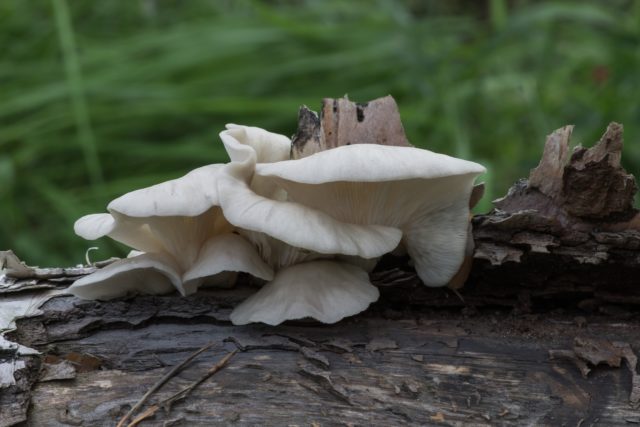
Oyster mushroom has a short stalk
Collection rules
Oyster mushrooms never grow alone. They are found in groups - from 7 to 15 pieces. One such bundle weighs about 1 kg. They are of interest to mushroom pickers because they can be collected quickly and in large quantities.
How to cook oyster mushrooms
They can be eaten in any form: fried, boiled, stewed, salted, pickled. They are dried, ground into powder, which has the smell of rye bread, and added to sauces.
They must be subjected to heat treatment. Young specimens should be cooked for about 20 minutes, older specimens take longer because they are tough.
Oyster mushrooms go well with meat and game; they are often used to make pureed soups, filling for pies, spicy Korean mushrooms, added to salads and pizza, fried with potatoes, baked in the oven and in a slow cooker.
Conclusion
Oyster mushroom is an edible mushroom that is grown artificially, but on a smaller scale than the ordinary one.It can also be found in the wild and is distributed throughout Europe. It is not a rare mushroom, but it is inconspicuous because it prefers to settle in hard-to-reach places.
